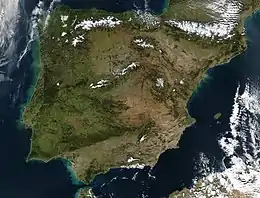Spanish irredentism
The target par excellence of Spanish irredentist claims has been the British overseas territory of Gibraltar whose long-standing territorial vindication as a (British) colony is enshrined in the Spanish foreign policy. Along history, other minor irredentist proposals have claimed territories such as Portugal, parts of Northern Africa or the Roussillon.
Iberian Union

A Spain holding all of the Iberian Peninsula became a topic in Spanish nationalism beginning in the 19th century, with proponents idealizing historical Roman Hispania when all of the Iberian Peninsula was united under the same rule.[1] The concept of Spain as a cultural and political unit had been developed centuries earlier with the publishing of Father Mariana's History of Spain (1598) in which Mariana supported a Hispanic identity.[1]
There has been strong Spanish objection to the separation of Gibraltar from Spain since British acquisition in the Treaty of Utrecht (1713) in the aftermath of the Spanish War of Succession.[2] During the Spanish Civil War, the Carlists and the Falange prior to the two parties' unification in 1937 both promoted the incorporation of Portugal into Spain. The Carlists stated that a Carlist Spain would retake Gibraltar and conquer Portugal.[3] The Falange, both prior to and after its merger with the Carlists, supported the unification of Gibraltar and Portugal into Spain, during its early years of existence the Falange produced maps of Spain that included Portugal as a province of Spain.[4] After the Spanish Civil War and the victory of the Nationalist faction led by Francisco Franco, radical members of the Falange called for the incorporation of Portugal and the French Pyrenees into Spain.[5] Franco in a communiqué with Germany on 26 May 1942 declared that Portugal should be annexed into Spain.[6]
The years of World War II were fertile in the projection by several authors of irredentist imaginaries across the Strait of Gibraltar (after all the Strait was to become the "neuralgic point of nationality" to them):[7] according to the africanist Tomás García Figueras "Spain and Morocco are like two halves of the same geographical unity".[8] Historian Jaume Vicens Vives (1940) talked about a "vital space" conceptualised as a "geopolitical basic unit".[9] Rodolfo Gil Benumeya traced the links back to the Neolithic, pointing to a common Ibero-Berber People living at both sides of the Strait.[10] Gil Benumeya and Hernández Pacheco stressed the strengthening of those links due to Morocco being part of "Hispania Tingitana". Some of these authors, transcending historical arguments, even pointed at a Spanish-African union during "the Tertiary" when the Strait would not have existed.[11]
To a lesser extent the territories adjacent to Equatorial Guinea were also subject to irredentist rhetoric in this time,[12] as well there were claims about the Spanishness of Andorra, the Roussillon, the Cerdanya or the Lower Navarre and the yearning for an approximation with Portugal.[13]
See also
References
- Kohl, Philip L.; Fawcett, Clare (1995). Nationalism, Politics, and the Practice of Archaeology. Cambridge: Cambridge University Press. pp. 41–42. ISBN 0-521-48065-5.
- Tibor Frank, Frank Hadler. Disputed territories and shared pasts: overlapping national histories in modern Europe. Palgrave Macmillan, 2011. P. 339.
- M. K. Flynn. Ideology, mobilization, and the nation: the rise of Irish, Basque, and Carlist national movements in the nineteenth and early twentieth centuries. Palgrave Macmillan, 1999. Pp. 178.
- Wayne H. Bowen. Spain during World War II. Columbia, Missouri, USA: University of Missouri Press, 2006. Pp. 26.
- Stanley G. Payne. Fascism in Spain, 1923-1977. Madison, Wisconsin, USA: The University of Wisconsin Press, 1999. P. 331.
- Paul Preston. Franco: a biography. BasicBooks, a division of HarperCollins, 1994. Pp. 857.
- Parra Montserrat 2012, p. 140.
- Parra Montserrat 2012, p. 137.
- Parra Montserrat 2012, p. 138.
- Parra Montserrat 2012, p. 208.
- Parra Montserrat 2012, pp. 138-139.
- Parra Montserrat 2012, p. 141.
- Parra Montserrat, David (2012). La narrativa del africanismo franquista. Génesis y prácticas socio-educativas (PDF). p. 142.CS1 maint: ref=harv (link)